BTEC HND Unit 4: Leadership, Management, and Operations Report
VerifiedAdded on 2023/01/19
|17
|4843
|21
Report
AI Summary
This report delves into the core concepts of leadership and management, offering a comprehensive analysis of their roles and functions within organizations. The report begins by defining and contrasting the characteristics of leaders and managers, providing examples from J.C. Bamford Excavators Ltd. (JCB) and Unilever to illustrate practical applications. It then examines how situational contexts influence the roles of both leaders and managers, exploring various leadership theories such as situational leadership and contingency approaches. The report further investigates key approaches to operations management, including the 'Just in Time' approach, and assesses factors within the business environment that can impact operations. The report aims to provide insights into effective leadership and management practices within a business context.

Management and
Operations
Operations
Paraphrase This Document
Need a fresh take? Get an instant paraphrase of this document with our AI Paraphraser
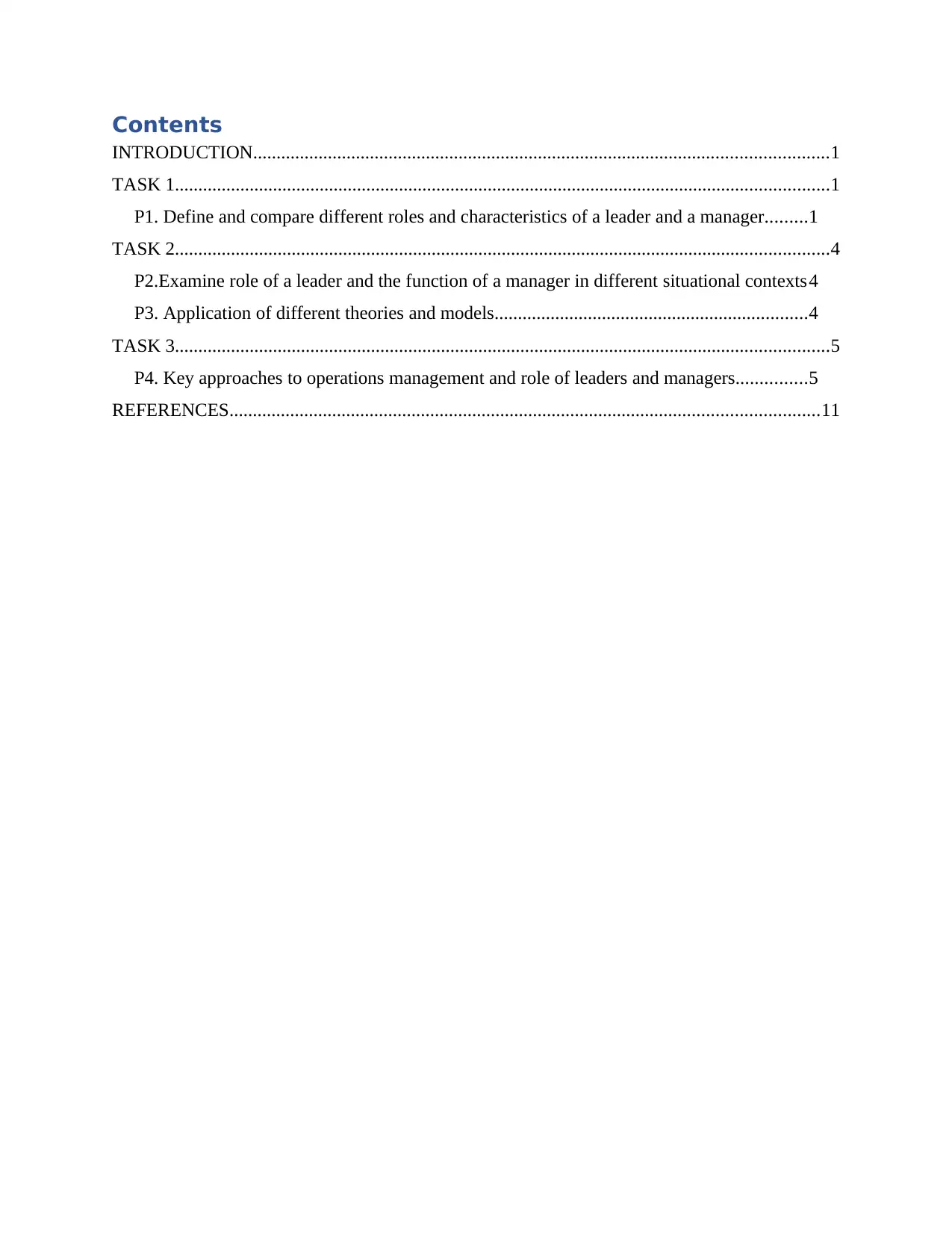
Contents
INTRODUCTION...........................................................................................................................1
TASK 1............................................................................................................................................1
P1. Define and compare different roles and characteristics of a leader and a manager.........1
TASK 2............................................................................................................................................4
P2.Examine role of a leader and the function of a manager in different situational contexts4
P3. Application of different theories and models...................................................................4
TASK 3............................................................................................................................................5
P4. Key approaches to operations management and role of leaders and managers...............5
REFERENCES..............................................................................................................................11
INTRODUCTION...........................................................................................................................1
TASK 1............................................................................................................................................1
P1. Define and compare different roles and characteristics of a leader and a manager.........1
TASK 2............................................................................................................................................4
P2.Examine role of a leader and the function of a manager in different situational contexts4
P3. Application of different theories and models...................................................................4
TASK 3............................................................................................................................................5
P4. Key approaches to operations management and role of leaders and managers...............5
REFERENCES..............................................................................................................................11

⊘ This is a preview!⊘
Do you want full access?
Subscribe today to unlock all pages.

Trusted by 1+ million students worldwide

INTRODUCTION
Operations in a business organisation refer to the activities and working within the
organisation. These are conducted in order to achieve the goals and objectives. These are divided
into various processes (Balasubramaniam and et. al., 2016). On the contrary, management
comprises of different actions such as planning, organising, briefing, staffing and controlling in
order to make employees accomplish the targets. However, the main aims of both of these are to
attainment of desired outcomes through transforming the raw materials into final goods or
services. For this first part of this file J. C. Bamford Excavators Ltd. (JCB) has been chosen
which is British multinational company having headquarters in Stafforshire, United Kingdom.
Whereas for the second part of the file Unilever is selected which is British-Dutch transnational
consumer goods co-headquartered in London, United Kingdom. Furthermore, this report
includes definition along with difference between a leader and manager, examples of their role
and function in different situations, application of various theories and models, key approaches
to operations management. Along with this, assessment of factors within business environment
which can impact.
TASK 1
P1. Define and compare different roles and characteristics of a leader and a manager
Leader is defined as an individual responsible for providing guidance and directions to
the team members for successful achievement of goals and objectives. There are specific roles
which are exercised by leaders for getting desired outcomes. Generally, it prepares bye laws and
rules to be followed by sub-ordinates.
On the other hand, manager is known to be a person having the responsibilities for
managing the people working in the organisation. Every single person has to report to a person
designated at this position (Christopher, 2016). Furthermore, some of the skills should be
possessed by the manager such as communication, problem solving, organisation etc. Employees
look up to their managers for taking inspiration.
Difference between leader and manager
1. Vision v goals Leaders have their aim fixed on goals to be achieved in future along with
the current goals. They encourage and motivate sub-ordinates to use their unique ideas
and creativity for achieving the goals. In the context of JCB, leaders of the company may
1
Operations in a business organisation refer to the activities and working within the
organisation. These are conducted in order to achieve the goals and objectives. These are divided
into various processes (Balasubramaniam and et. al., 2016). On the contrary, management
comprises of different actions such as planning, organising, briefing, staffing and controlling in
order to make employees accomplish the targets. However, the main aims of both of these are to
attainment of desired outcomes through transforming the raw materials into final goods or
services. For this first part of this file J. C. Bamford Excavators Ltd. (JCB) has been chosen
which is British multinational company having headquarters in Stafforshire, United Kingdom.
Whereas for the second part of the file Unilever is selected which is British-Dutch transnational
consumer goods co-headquartered in London, United Kingdom. Furthermore, this report
includes definition along with difference between a leader and manager, examples of their role
and function in different situations, application of various theories and models, key approaches
to operations management. Along with this, assessment of factors within business environment
which can impact.
TASK 1
P1. Define and compare different roles and characteristics of a leader and a manager
Leader is defined as an individual responsible for providing guidance and directions to
the team members for successful achievement of goals and objectives. There are specific roles
which are exercised by leaders for getting desired outcomes. Generally, it prepares bye laws and
rules to be followed by sub-ordinates.
On the other hand, manager is known to be a person having the responsibilities for
managing the people working in the organisation. Every single person has to report to a person
designated at this position (Christopher, 2016). Furthermore, some of the skills should be
possessed by the manager such as communication, problem solving, organisation etc. Employees
look up to their managers for taking inspiration.
Difference between leader and manager
1. Vision v goals Leaders have their aim fixed on goals to be achieved in future along with
the current goals. They encourage and motivate sub-ordinates to use their unique ideas
and creativity for achieving the goals. In the context of JCB, leaders of the company may
1
Paraphrase This Document
Need a fresh take? Get an instant paraphrase of this document with our AI Paraphraser
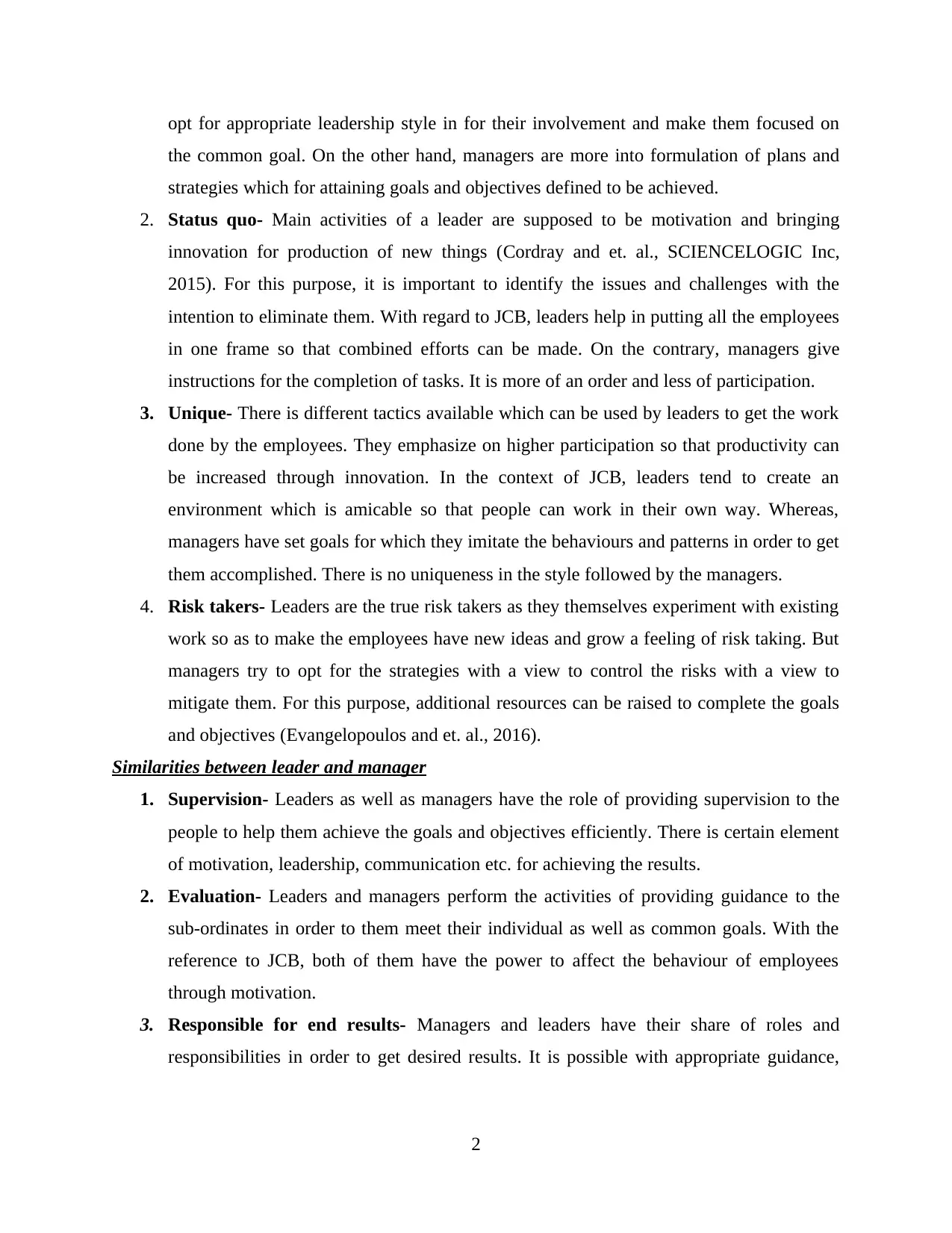
opt for appropriate leadership style in for their involvement and make them focused on
the common goal. On the other hand, managers are more into formulation of plans and
strategies which for attaining goals and objectives defined to be achieved.
2. Status quo- Main activities of a leader are supposed to be motivation and bringing
innovation for production of new things (Cordray and et. al., SCIENCELOGIC Inc,
2015). For this purpose, it is important to identify the issues and challenges with the
intention to eliminate them. With regard to JCB, leaders help in putting all the employees
in one frame so that combined efforts can be made. On the contrary, managers give
instructions for the completion of tasks. It is more of an order and less of participation.
3. Unique- There is different tactics available which can be used by leaders to get the work
done by the employees. They emphasize on higher participation so that productivity can
be increased through innovation. In the context of JCB, leaders tend to create an
environment which is amicable so that people can work in their own way. Whereas,
managers have set goals for which they imitate the behaviours and patterns in order to get
them accomplished. There is no uniqueness in the style followed by the managers.
4. Risk takers- Leaders are the true risk takers as they themselves experiment with existing
work so as to make the employees have new ideas and grow a feeling of risk taking. But
managers try to opt for the strategies with a view to control the risks with a view to
mitigate them. For this purpose, additional resources can be raised to complete the goals
and objectives (Evangelopoulos and et. al., 2016).
Similarities between leader and manager
1. Supervision- Leaders as well as managers have the role of providing supervision to the
people to help them achieve the goals and objectives efficiently. There is certain element
of motivation, leadership, communication etc. for achieving the results.
2. Evaluation- Leaders and managers perform the activities of providing guidance to the
sub-ordinates in order to them meet their individual as well as common goals. With the
reference to JCB, both of them have the power to affect the behaviour of employees
through motivation.
3. Responsible for end results- Managers and leaders have their share of roles and
responsibilities in order to get desired results. It is possible with appropriate guidance,
2
the common goal. On the other hand, managers are more into formulation of plans and
strategies which for attaining goals and objectives defined to be achieved.
2. Status quo- Main activities of a leader are supposed to be motivation and bringing
innovation for production of new things (Cordray and et. al., SCIENCELOGIC Inc,
2015). For this purpose, it is important to identify the issues and challenges with the
intention to eliminate them. With regard to JCB, leaders help in putting all the employees
in one frame so that combined efforts can be made. On the contrary, managers give
instructions for the completion of tasks. It is more of an order and less of participation.
3. Unique- There is different tactics available which can be used by leaders to get the work
done by the employees. They emphasize on higher participation so that productivity can
be increased through innovation. In the context of JCB, leaders tend to create an
environment which is amicable so that people can work in their own way. Whereas,
managers have set goals for which they imitate the behaviours and patterns in order to get
them accomplished. There is no uniqueness in the style followed by the managers.
4. Risk takers- Leaders are the true risk takers as they themselves experiment with existing
work so as to make the employees have new ideas and grow a feeling of risk taking. But
managers try to opt for the strategies with a view to control the risks with a view to
mitigate them. For this purpose, additional resources can be raised to complete the goals
and objectives (Evangelopoulos and et. al., 2016).
Similarities between leader and manager
1. Supervision- Leaders as well as managers have the role of providing supervision to the
people to help them achieve the goals and objectives efficiently. There is certain element
of motivation, leadership, communication etc. for achieving the results.
2. Evaluation- Leaders and managers perform the activities of providing guidance to the
sub-ordinates in order to them meet their individual as well as common goals. With the
reference to JCB, both of them have the power to affect the behaviour of employees
through motivation.
3. Responsible for end results- Managers and leaders have their share of roles and
responsibilities in order to get desired results. It is possible with appropriate guidance,
2
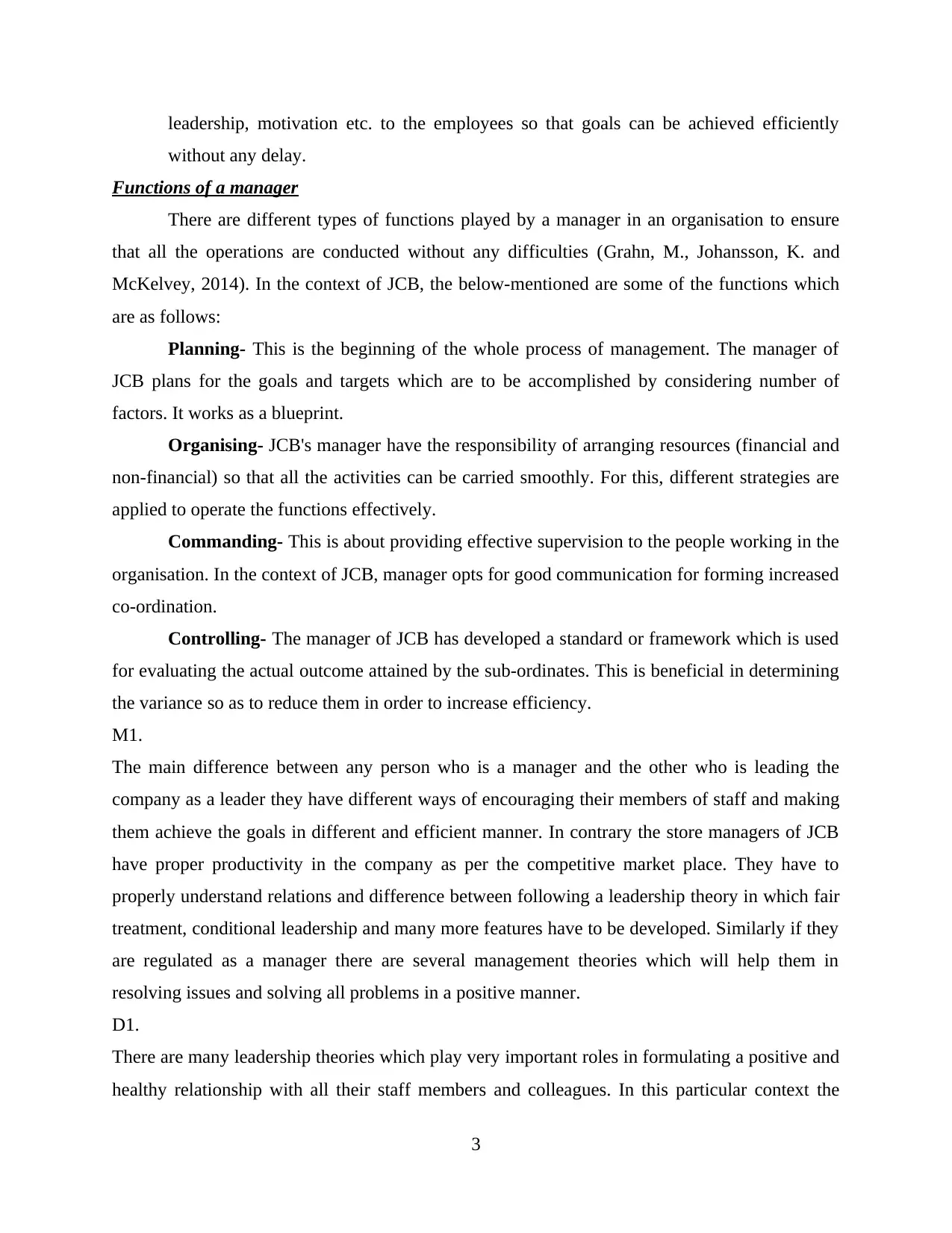
leadership, motivation etc. to the employees so that goals can be achieved efficiently
without any delay.
Functions of a manager
There are different types of functions played by a manager in an organisation to ensure
that all the operations are conducted without any difficulties (Grahn, M., Johansson, K. and
McKelvey, 2014). In the context of JCB, the below-mentioned are some of the functions which
are as follows:
Planning- This is the beginning of the whole process of management. The manager of
JCB plans for the goals and targets which are to be accomplished by considering number of
factors. It works as a blueprint.
Organising- JCB's manager have the responsibility of arranging resources (financial and
non-financial) so that all the activities can be carried smoothly. For this, different strategies are
applied to operate the functions effectively.
Commanding- This is about providing effective supervision to the people working in the
organisation. In the context of JCB, manager opts for good communication for forming increased
co-ordination.
Controlling- The manager of JCB has developed a standard or framework which is used
for evaluating the actual outcome attained by the sub-ordinates. This is beneficial in determining
the variance so as to reduce them in order to increase efficiency.
M1.
The main difference between any person who is a manager and the other who is leading the
company as a leader they have different ways of encouraging their members of staff and making
them achieve the goals in different and efficient manner. In contrary the store managers of JCB
have proper productivity in the company as per the competitive market place. They have to
properly understand relations and difference between following a leadership theory in which fair
treatment, conditional leadership and many more features have to be developed. Similarly if they
are regulated as a manager there are several management theories which will help them in
resolving issues and solving all problems in a positive manner.
D1.
There are many leadership theories which play very important roles in formulating a positive and
healthy relationship with all their staff members and colleagues. In this particular context the
3
without any delay.
Functions of a manager
There are different types of functions played by a manager in an organisation to ensure
that all the operations are conducted without any difficulties (Grahn, M., Johansson, K. and
McKelvey, 2014). In the context of JCB, the below-mentioned are some of the functions which
are as follows:
Planning- This is the beginning of the whole process of management. The manager of
JCB plans for the goals and targets which are to be accomplished by considering number of
factors. It works as a blueprint.
Organising- JCB's manager have the responsibility of arranging resources (financial and
non-financial) so that all the activities can be carried smoothly. For this, different strategies are
applied to operate the functions effectively.
Commanding- This is about providing effective supervision to the people working in the
organisation. In the context of JCB, manager opts for good communication for forming increased
co-ordination.
Controlling- The manager of JCB has developed a standard or framework which is used
for evaluating the actual outcome attained by the sub-ordinates. This is beneficial in determining
the variance so as to reduce them in order to increase efficiency.
M1.
The main difference between any person who is a manager and the other who is leading the
company as a leader they have different ways of encouraging their members of staff and making
them achieve the goals in different and efficient manner. In contrary the store managers of JCB
have proper productivity in the company as per the competitive market place. They have to
properly understand relations and difference between following a leadership theory in which fair
treatment, conditional leadership and many more features have to be developed. Similarly if they
are regulated as a manager there are several management theories which will help them in
resolving issues and solving all problems in a positive manner.
D1.
There are many leadership theories which play very important roles in formulating a positive and
healthy relationship with all their staff members and colleagues. In this particular context the
3
⊘ This is a preview!⊘
Do you want full access?
Subscribe today to unlock all pages.

Trusted by 1+ million students worldwide
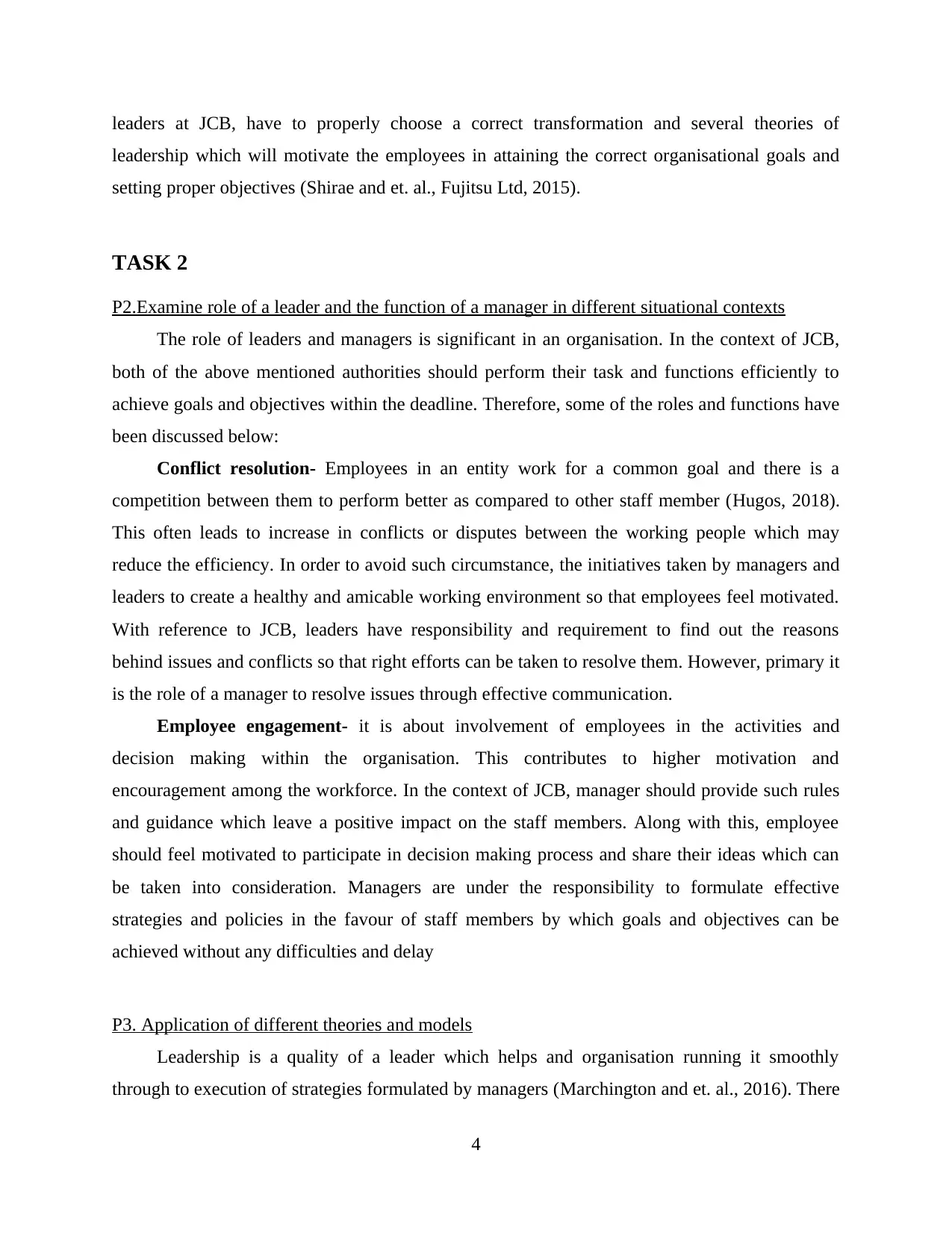
leaders at JCB, have to properly choose a correct transformation and several theories of
leadership which will motivate the employees in attaining the correct organisational goals and
setting proper objectives (Shirae and et. al., Fujitsu Ltd, 2015).
TASK 2
P2.Examine role of a leader and the function of a manager in different situational contexts
The role of leaders and managers is significant in an organisation. In the context of JCB,
both of the above mentioned authorities should perform their task and functions efficiently to
achieve goals and objectives within the deadline. Therefore, some of the roles and functions have
been discussed below:
Conflict resolution- Employees in an entity work for a common goal and there is a
competition between them to perform better as compared to other staff member (Hugos, 2018).
This often leads to increase in conflicts or disputes between the working people which may
reduce the efficiency. In order to avoid such circumstance, the initiatives taken by managers and
leaders to create a healthy and amicable working environment so that employees feel motivated.
With reference to JCB, leaders have responsibility and requirement to find out the reasons
behind issues and conflicts so that right efforts can be taken to resolve them. However, primary it
is the role of a manager to resolve issues through effective communication.
Employee engagement- it is about involvement of employees in the activities and
decision making within the organisation. This contributes to higher motivation and
encouragement among the workforce. In the context of JCB, manager should provide such rules
and guidance which leave a positive impact on the staff members. Along with this, employee
should feel motivated to participate in decision making process and share their ideas which can
be taken into consideration. Managers are under the responsibility to formulate effective
strategies and policies in the favour of staff members by which goals and objectives can be
achieved without any difficulties and delay
P3. Application of different theories and models
Leadership is a quality of a leader which helps and organisation running it smoothly
through to execution of strategies formulated by managers (Marchington and et. al., 2016). There
4
leadership which will motivate the employees in attaining the correct organisational goals and
setting proper objectives (Shirae and et. al., Fujitsu Ltd, 2015).
TASK 2
P2.Examine role of a leader and the function of a manager in different situational contexts
The role of leaders and managers is significant in an organisation. In the context of JCB,
both of the above mentioned authorities should perform their task and functions efficiently to
achieve goals and objectives within the deadline. Therefore, some of the roles and functions have
been discussed below:
Conflict resolution- Employees in an entity work for a common goal and there is a
competition between them to perform better as compared to other staff member (Hugos, 2018).
This often leads to increase in conflicts or disputes between the working people which may
reduce the efficiency. In order to avoid such circumstance, the initiatives taken by managers and
leaders to create a healthy and amicable working environment so that employees feel motivated.
With reference to JCB, leaders have responsibility and requirement to find out the reasons
behind issues and conflicts so that right efforts can be taken to resolve them. However, primary it
is the role of a manager to resolve issues through effective communication.
Employee engagement- it is about involvement of employees in the activities and
decision making within the organisation. This contributes to higher motivation and
encouragement among the workforce. In the context of JCB, manager should provide such rules
and guidance which leave a positive impact on the staff members. Along with this, employee
should feel motivated to participate in decision making process and share their ideas which can
be taken into consideration. Managers are under the responsibility to formulate effective
strategies and policies in the favour of staff members by which goals and objectives can be
achieved without any difficulties and delay
P3. Application of different theories and models
Leadership is a quality of a leader which helps and organisation running it smoothly
through to execution of strategies formulated by managers (Marchington and et. al., 2016). There
4
Paraphrase This Document
Need a fresh take? Get an instant paraphrase of this document with our AI Paraphraser
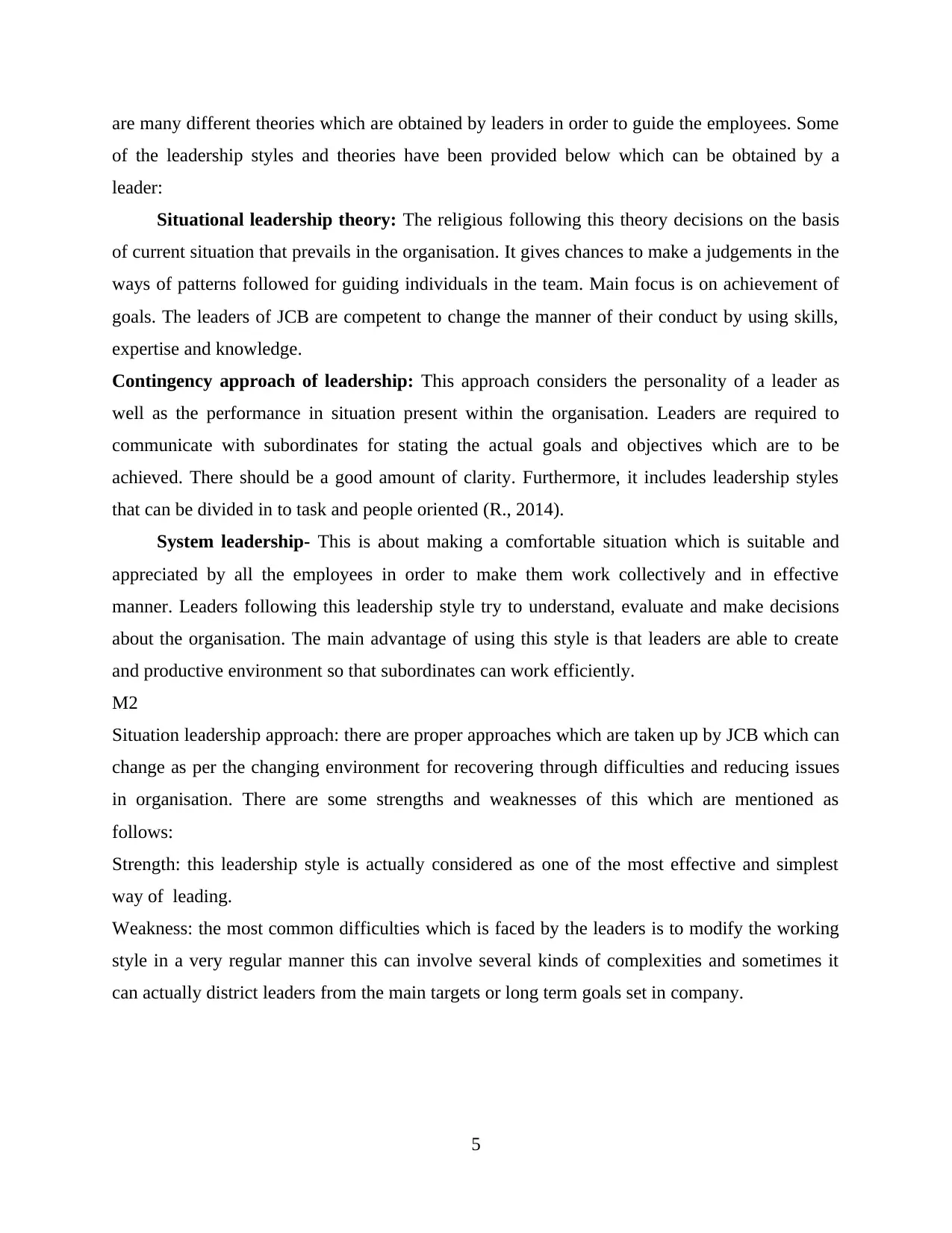
are many different theories which are obtained by leaders in order to guide the employees. Some
of the leadership styles and theories have been provided below which can be obtained by a
leader:
Situational leadership theory: The religious following this theory decisions on the basis
of current situation that prevails in the organisation. It gives chances to make a judgements in the
ways of patterns followed for guiding individuals in the team. Main focus is on achievement of
goals. The leaders of JCB are competent to change the manner of their conduct by using skills,
expertise and knowledge.
Contingency approach of leadership: This approach considers the personality of a leader as
well as the performance in situation present within the organisation. Leaders are required to
communicate with subordinates for stating the actual goals and objectives which are to be
achieved. There should be a good amount of clarity. Furthermore, it includes leadership styles
that can be divided in to task and people oriented (R., 2014).
System leadership- This is about making a comfortable situation which is suitable and
appreciated by all the employees in order to make them work collectively and in effective
manner. Leaders following this leadership style try to understand, evaluate and make decisions
about the organisation. The main advantage of using this style is that leaders are able to create
and productive environment so that subordinates can work efficiently.
M2
Situation leadership approach: there are proper approaches which are taken up by JCB which can
change as per the changing environment for recovering through difficulties and reducing issues
in organisation. There are some strengths and weaknesses of this which are mentioned as
follows:
Strength: this leadership style is actually considered as one of the most effective and simplest
way of leading.
Weakness: the most common difficulties which is faced by the leaders is to modify the working
style in a very regular manner this can involve several kinds of complexities and sometimes it
can actually district leaders from the main targets or long term goals set in company.
5
of the leadership styles and theories have been provided below which can be obtained by a
leader:
Situational leadership theory: The religious following this theory decisions on the basis
of current situation that prevails in the organisation. It gives chances to make a judgements in the
ways of patterns followed for guiding individuals in the team. Main focus is on achievement of
goals. The leaders of JCB are competent to change the manner of their conduct by using skills,
expertise and knowledge.
Contingency approach of leadership: This approach considers the personality of a leader as
well as the performance in situation present within the organisation. Leaders are required to
communicate with subordinates for stating the actual goals and objectives which are to be
achieved. There should be a good amount of clarity. Furthermore, it includes leadership styles
that can be divided in to task and people oriented (R., 2014).
System leadership- This is about making a comfortable situation which is suitable and
appreciated by all the employees in order to make them work collectively and in effective
manner. Leaders following this leadership style try to understand, evaluate and make decisions
about the organisation. The main advantage of using this style is that leaders are able to create
and productive environment so that subordinates can work efficiently.
M2
Situation leadership approach: there are proper approaches which are taken up by JCB which can
change as per the changing environment for recovering through difficulties and reducing issues
in organisation. There are some strengths and weaknesses of this which are mentioned as
follows:
Strength: this leadership style is actually considered as one of the most effective and simplest
way of leading.
Weakness: the most common difficulties which is faced by the leaders is to modify the working
style in a very regular manner this can involve several kinds of complexities and sometimes it
can actually district leaders from the main targets or long term goals set in company.
5
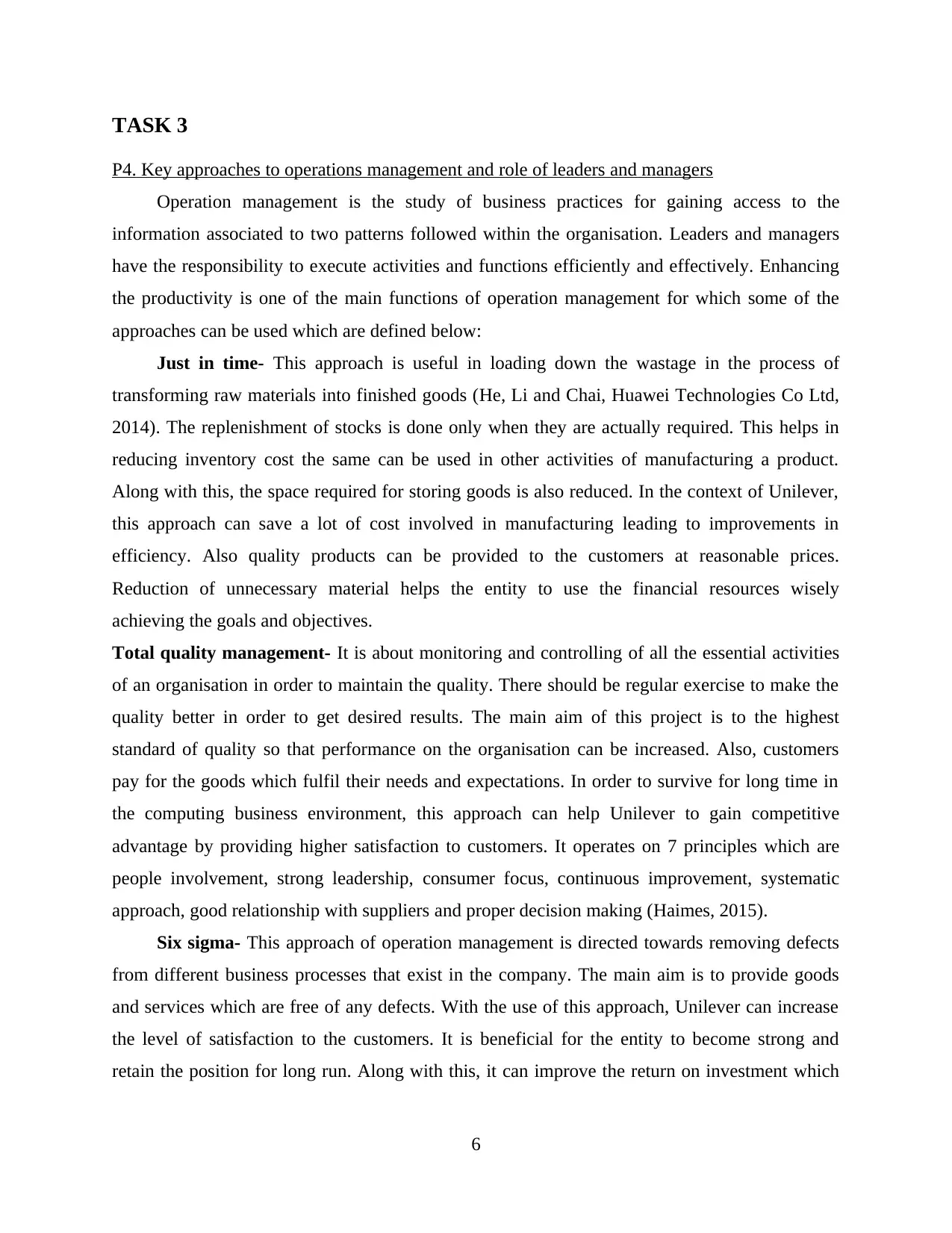
TASK 3
P4. Key approaches to operations management and role of leaders and managers
Operation management is the study of business practices for gaining access to the
information associated to two patterns followed within the organisation. Leaders and managers
have the responsibility to execute activities and functions efficiently and effectively. Enhancing
the productivity is one of the main functions of operation management for which some of the
approaches can be used which are defined below:
Just in time- This approach is useful in loading down the wastage in the process of
transforming raw materials into finished goods (He, Li and Chai, Huawei Technologies Co Ltd,
2014). The replenishment of stocks is done only when they are actually required. This helps in
reducing inventory cost the same can be used in other activities of manufacturing a product.
Along with this, the space required for storing goods is also reduced. In the context of Unilever,
this approach can save a lot of cost involved in manufacturing leading to improvements in
efficiency. Also quality products can be provided to the customers at reasonable prices.
Reduction of unnecessary material helps the entity to use the financial resources wisely
achieving the goals and objectives.
Total quality management- It is about monitoring and controlling of all the essential activities
of an organisation in order to maintain the quality. There should be regular exercise to make the
quality better in order to get desired results. The main aim of this project is to the highest
standard of quality so that performance on the organisation can be increased. Also, customers
pay for the goods which fulfil their needs and expectations. In order to survive for long time in
the computing business environment, this approach can help Unilever to gain competitive
advantage by providing higher satisfaction to customers. It operates on 7 principles which are
people involvement, strong leadership, consumer focus, continuous improvement, systematic
approach, good relationship with suppliers and proper decision making (Haimes, 2015).
Six sigma- This approach of operation management is directed towards removing defects
from different business processes that exist in the company. The main aim is to provide goods
and services which are free of any defects. With the use of this approach, Unilever can increase
the level of satisfaction to the customers. It is beneficial for the entity to become strong and
retain the position for long run. Along with this, it can improve the return on investment which
6
P4. Key approaches to operations management and role of leaders and managers
Operation management is the study of business practices for gaining access to the
information associated to two patterns followed within the organisation. Leaders and managers
have the responsibility to execute activities and functions efficiently and effectively. Enhancing
the productivity is one of the main functions of operation management for which some of the
approaches can be used which are defined below:
Just in time- This approach is useful in loading down the wastage in the process of
transforming raw materials into finished goods (He, Li and Chai, Huawei Technologies Co Ltd,
2014). The replenishment of stocks is done only when they are actually required. This helps in
reducing inventory cost the same can be used in other activities of manufacturing a product.
Along with this, the space required for storing goods is also reduced. In the context of Unilever,
this approach can save a lot of cost involved in manufacturing leading to improvements in
efficiency. Also quality products can be provided to the customers at reasonable prices.
Reduction of unnecessary material helps the entity to use the financial resources wisely
achieving the goals and objectives.
Total quality management- It is about monitoring and controlling of all the essential activities
of an organisation in order to maintain the quality. There should be regular exercise to make the
quality better in order to get desired results. The main aim of this project is to the highest
standard of quality so that performance on the organisation can be increased. Also, customers
pay for the goods which fulfil their needs and expectations. In order to survive for long time in
the computing business environment, this approach can help Unilever to gain competitive
advantage by providing higher satisfaction to customers. It operates on 7 principles which are
people involvement, strong leadership, consumer focus, continuous improvement, systematic
approach, good relationship with suppliers and proper decision making (Haimes, 2015).
Six sigma- This approach of operation management is directed towards removing defects
from different business processes that exist in the company. The main aim is to provide goods
and services which are free of any defects. With the use of this approach, Unilever can increase
the level of satisfaction to the customers. It is beneficial for the entity to become strong and
retain the position for long run. Along with this, it can improve the return on investment which
6
⊘ This is a preview!⊘
Do you want full access?
Subscribe today to unlock all pages.

Trusted by 1+ million students worldwide
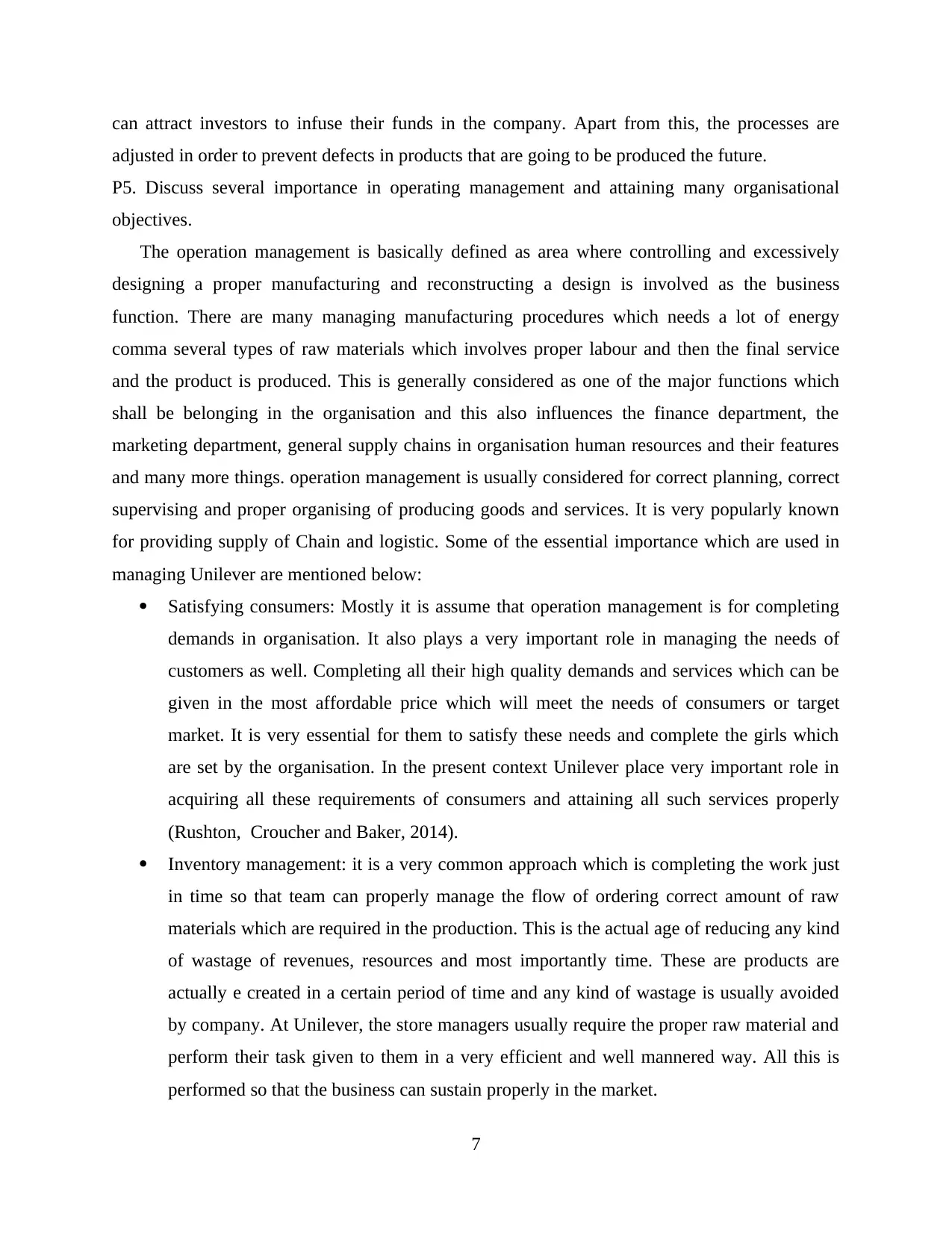
can attract investors to infuse their funds in the company. Apart from this, the processes are
adjusted in order to prevent defects in products that are going to be produced the future.
P5. Discuss several importance in operating management and attaining many organisational
objectives.
The operation management is basically defined as area where controlling and excessively
designing a proper manufacturing and reconstructing a design is involved as the business
function. There are many managing manufacturing procedures which needs a lot of energy
comma several types of raw materials which involves proper labour and then the final service
and the product is produced. This is generally considered as one of the major functions which
shall be belonging in the organisation and this also influences the finance department, the
marketing department, general supply chains in organisation human resources and their features
and many more things. operation management is usually considered for correct planning, correct
supervising and proper organising of producing goods and services. It is very popularly known
for providing supply of Chain and logistic. Some of the essential importance which are used in
managing Unilever are mentioned below:
Satisfying consumers: Mostly it is assume that operation management is for completing
demands in organisation. It also plays a very important role in managing the needs of
customers as well. Completing all their high quality demands and services which can be
given in the most affordable price which will meet the needs of consumers or target
market. It is very essential for them to satisfy these needs and complete the girls which
are set by the organisation. In the present context Unilever place very important role in
acquiring all these requirements of consumers and attaining all such services properly
(Rushton, Croucher and Baker, 2014).
Inventory management: it is a very common approach which is completing the work just
in time so that team can properly manage the flow of ordering correct amount of raw
materials which are required in the production. This is the actual age of reducing any kind
of wastage of revenues, resources and most importantly time. These are products are
actually e created in a certain period of time and any kind of wastage is usually avoided
by company. At Unilever, the store managers usually require the proper raw material and
perform their task given to them in a very efficient and well mannered way. All this is
performed so that the business can sustain properly in the market.
7
adjusted in order to prevent defects in products that are going to be produced the future.
P5. Discuss several importance in operating management and attaining many organisational
objectives.
The operation management is basically defined as area where controlling and excessively
designing a proper manufacturing and reconstructing a design is involved as the business
function. There are many managing manufacturing procedures which needs a lot of energy
comma several types of raw materials which involves proper labour and then the final service
and the product is produced. This is generally considered as one of the major functions which
shall be belonging in the organisation and this also influences the finance department, the
marketing department, general supply chains in organisation human resources and their features
and many more things. operation management is usually considered for correct planning, correct
supervising and proper organising of producing goods and services. It is very popularly known
for providing supply of Chain and logistic. Some of the essential importance which are used in
managing Unilever are mentioned below:
Satisfying consumers: Mostly it is assume that operation management is for completing
demands in organisation. It also plays a very important role in managing the needs of
customers as well. Completing all their high quality demands and services which can be
given in the most affordable price which will meet the needs of consumers or target
market. It is very essential for them to satisfy these needs and complete the girls which
are set by the organisation. In the present context Unilever place very important role in
acquiring all these requirements of consumers and attaining all such services properly
(Rushton, Croucher and Baker, 2014).
Inventory management: it is a very common approach which is completing the work just
in time so that team can properly manage the flow of ordering correct amount of raw
materials which are required in the production. This is the actual age of reducing any kind
of wastage of revenues, resources and most importantly time. These are products are
actually e created in a certain period of time and any kind of wastage is usually avoided
by company. At Unilever, the store managers usually require the proper raw material and
perform their task given to them in a very efficient and well mannered way. All this is
performed so that the business can sustain properly in the market.
7
Paraphrase This Document
Need a fresh take? Get an instant paraphrase of this document with our AI Paraphraser
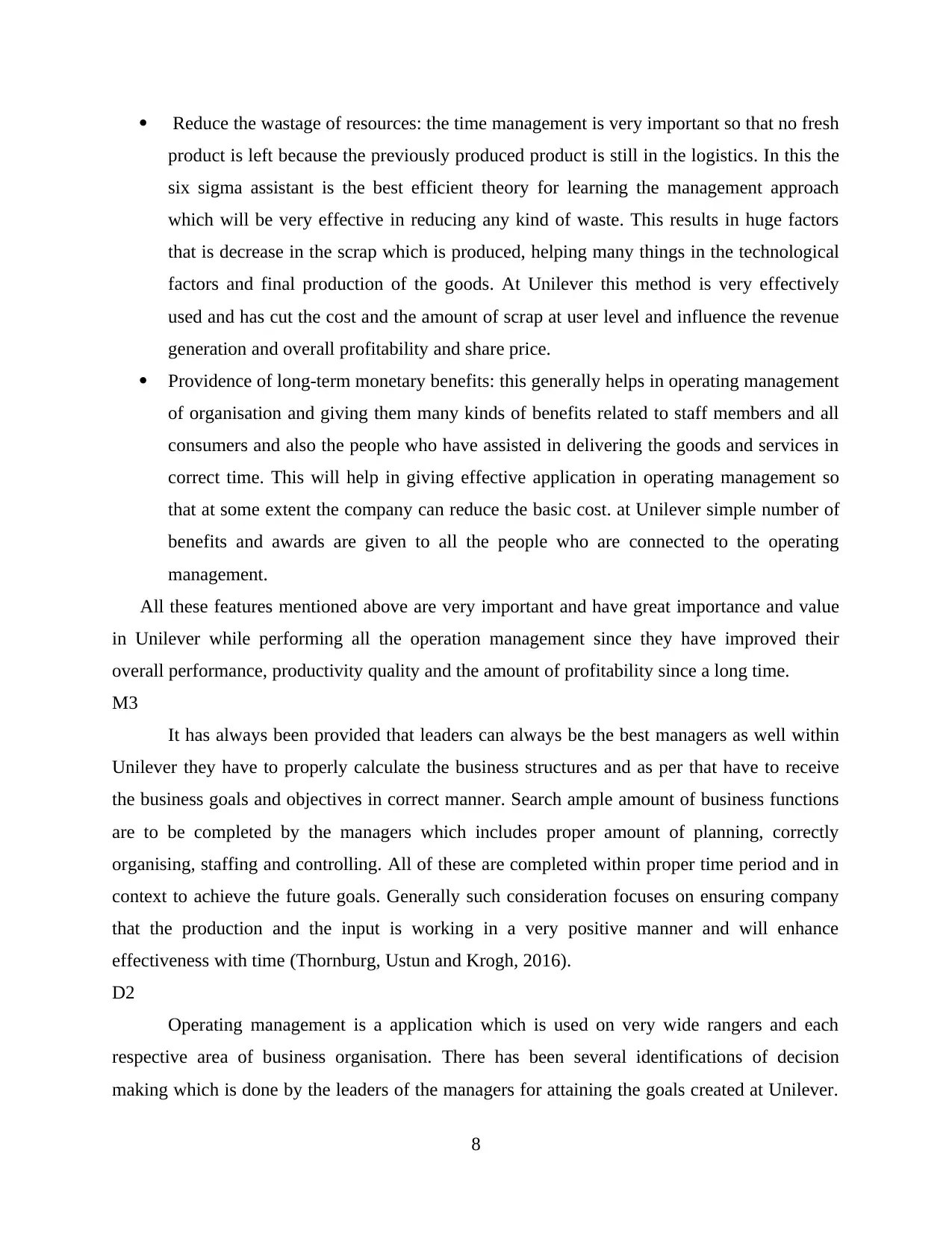
Reduce the wastage of resources: the time management is very important so that no fresh
product is left because the previously produced product is still in the logistics. In this the
six sigma assistant is the best efficient theory for learning the management approach
which will be very effective in reducing any kind of waste. This results in huge factors
that is decrease in the scrap which is produced, helping many things in the technological
factors and final production of the goods. At Unilever this method is very effectively
used and has cut the cost and the amount of scrap at user level and influence the revenue
generation and overall profitability and share price.
Providence of long-term monetary benefits: this generally helps in operating management
of organisation and giving them many kinds of benefits related to staff members and all
consumers and also the people who have assisted in delivering the goods and services in
correct time. This will help in giving effective application in operating management so
that at some extent the company can reduce the basic cost. at Unilever simple number of
benefits and awards are given to all the people who are connected to the operating
management.
All these features mentioned above are very important and have great importance and value
in Unilever while performing all the operation management since they have improved their
overall performance, productivity quality and the amount of profitability since a long time.
M3
It has always been provided that leaders can always be the best managers as well within
Unilever they have to properly calculate the business structures and as per that have to receive
the business goals and objectives in correct manner. Search ample amount of business functions
are to be completed by the managers which includes proper amount of planning, correctly
organising, staffing and controlling. All of these are completed within proper time period and in
context to achieve the future goals. Generally such consideration focuses on ensuring company
that the production and the input is working in a very positive manner and will enhance
effectiveness with time (Thornburg, Ustun and Krogh, 2016).
D2
Operating management is a application which is used on very wide rangers and each
respective area of business organisation. There has been several identifications of decision
making which is done by the leaders of the managers for attaining the goals created at Unilever.
8
product is left because the previously produced product is still in the logistics. In this the
six sigma assistant is the best efficient theory for learning the management approach
which will be very effective in reducing any kind of waste. This results in huge factors
that is decrease in the scrap which is produced, helping many things in the technological
factors and final production of the goods. At Unilever this method is very effectively
used and has cut the cost and the amount of scrap at user level and influence the revenue
generation and overall profitability and share price.
Providence of long-term monetary benefits: this generally helps in operating management
of organisation and giving them many kinds of benefits related to staff members and all
consumers and also the people who have assisted in delivering the goods and services in
correct time. This will help in giving effective application in operating management so
that at some extent the company can reduce the basic cost. at Unilever simple number of
benefits and awards are given to all the people who are connected to the operating
management.
All these features mentioned above are very important and have great importance and value
in Unilever while performing all the operation management since they have improved their
overall performance, productivity quality and the amount of profitability since a long time.
M3
It has always been provided that leaders can always be the best managers as well within
Unilever they have to properly calculate the business structures and as per that have to receive
the business goals and objectives in correct manner. Search ample amount of business functions
are to be completed by the managers which includes proper amount of planning, correctly
organising, staffing and controlling. All of these are completed within proper time period and in
context to achieve the future goals. Generally such consideration focuses on ensuring company
that the production and the input is working in a very positive manner and will enhance
effectiveness with time (Thornburg, Ustun and Krogh, 2016).
D2
Operating management is a application which is used on very wide rangers and each
respective area of business organisation. There has been several identifications of decision
making which is done by the leaders of the managers for attaining the goals created at Unilever.
8
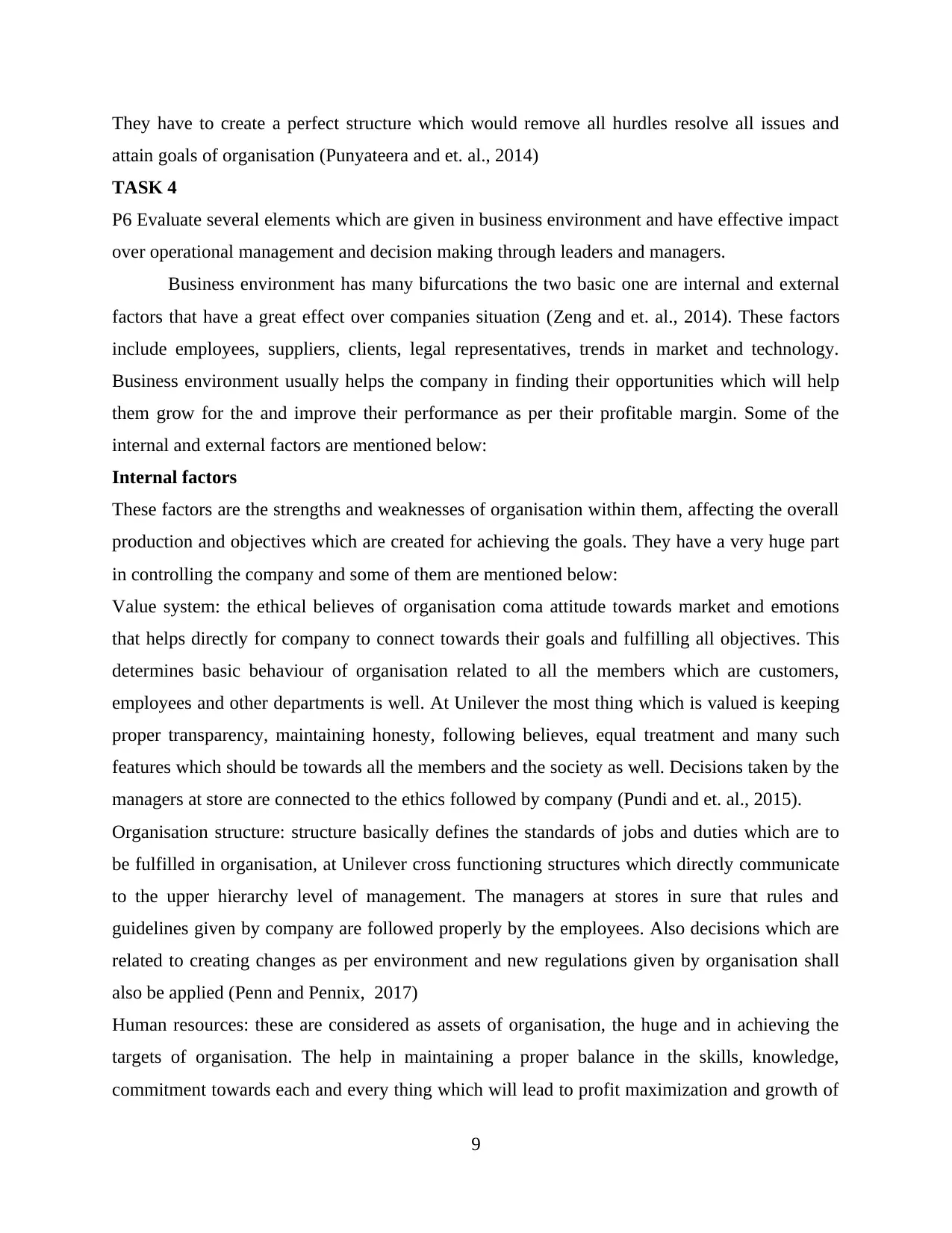
They have to create a perfect structure which would remove all hurdles resolve all issues and
attain goals of organisation (Punyateera and et. al., 2014)
TASK 4
P6 Evaluate several elements which are given in business environment and have effective impact
over operational management and decision making through leaders and managers.
Business environment has many bifurcations the two basic one are internal and external
factors that have a great effect over companies situation (Zeng and et. al., 2014). These factors
include employees, suppliers, clients, legal representatives, trends in market and technology.
Business environment usually helps the company in finding their opportunities which will help
them grow for the and improve their performance as per their profitable margin. Some of the
internal and external factors are mentioned below:
Internal factors
These factors are the strengths and weaknesses of organisation within them, affecting the overall
production and objectives which are created for achieving the goals. They have a very huge part
in controlling the company and some of them are mentioned below:
Value system: the ethical believes of organisation coma attitude towards market and emotions
that helps directly for company to connect towards their goals and fulfilling all objectives. This
determines basic behaviour of organisation related to all the members which are customers,
employees and other departments is well. At Unilever the most thing which is valued is keeping
proper transparency, maintaining honesty, following believes, equal treatment and many such
features which should be towards all the members and the society as well. Decisions taken by the
managers at store are connected to the ethics followed by company (Pundi and et. al., 2015).
Organisation structure: structure basically defines the standards of jobs and duties which are to
be fulfilled in organisation, at Unilever cross functioning structures which directly communicate
to the upper hierarchy level of management. The managers at stores in sure that rules and
guidelines given by company are followed properly by the employees. Also decisions which are
related to creating changes as per environment and new regulations given by organisation shall
also be applied (Penn and Pennix, 2017)
Human resources: these are considered as assets of organisation, the huge and in achieving the
targets of organisation. The help in maintaining a proper balance in the skills, knowledge,
commitment towards each and every thing which will lead to profit maximization and growth of
9
attain goals of organisation (Punyateera and et. al., 2014)
TASK 4
P6 Evaluate several elements which are given in business environment and have effective impact
over operational management and decision making through leaders and managers.
Business environment has many bifurcations the two basic one are internal and external
factors that have a great effect over companies situation (Zeng and et. al., 2014). These factors
include employees, suppliers, clients, legal representatives, trends in market and technology.
Business environment usually helps the company in finding their opportunities which will help
them grow for the and improve their performance as per their profitable margin. Some of the
internal and external factors are mentioned below:
Internal factors
These factors are the strengths and weaknesses of organisation within them, affecting the overall
production and objectives which are created for achieving the goals. They have a very huge part
in controlling the company and some of them are mentioned below:
Value system: the ethical believes of organisation coma attitude towards market and emotions
that helps directly for company to connect towards their goals and fulfilling all objectives. This
determines basic behaviour of organisation related to all the members which are customers,
employees and other departments is well. At Unilever the most thing which is valued is keeping
proper transparency, maintaining honesty, following believes, equal treatment and many such
features which should be towards all the members and the society as well. Decisions taken by the
managers at store are connected to the ethics followed by company (Pundi and et. al., 2015).
Organisation structure: structure basically defines the standards of jobs and duties which are to
be fulfilled in organisation, at Unilever cross functioning structures which directly communicate
to the upper hierarchy level of management. The managers at stores in sure that rules and
guidelines given by company are followed properly by the employees. Also decisions which are
related to creating changes as per environment and new regulations given by organisation shall
also be applied (Penn and Pennix, 2017)
Human resources: these are considered as assets of organisation, the huge and in achieving the
targets of organisation. The help in maintaining a proper balance in the skills, knowledge,
commitment towards each and every thing which will lead to profit maximization and growth of
9
⊘ This is a preview!⊘
Do you want full access?
Subscribe today to unlock all pages.

Trusted by 1+ million students worldwide
1 out of 17
Related Documents
Your All-in-One AI-Powered Toolkit for Academic Success.
+13062052269
info@desklib.com
Available 24*7 on WhatsApp / Email
![[object Object]](/_next/static/media/star-bottom.7253800d.svg)
Unlock your academic potential
Copyright © 2020–2025 A2Z Services. All Rights Reserved. Developed and managed by ZUCOL.





